Weekly Advanced Technologies〔72〕

Weekly Advanced Technologies〔72〕| High-Efficiency Tumor Therapy Achieved Through Breakthrough in DNA Origami Nanoreactor Technology; Decoding the Marine Microbiome at Single-Cell Resolution: Turning Cyclohexane into a Valuable Resource
Reactive oxygen species (ROS)-based oncology therapies, including photodynamic, sonodynamic, and chemodynamic therapies, are promising due to their ability to target and damage tumor cells. Unlike photodynamic and sonodynamic therapies, which rely on external stimuli like light or ultrasound, chemodynamic therapy (CDT) utilizes the Fenton reaction to convert endogenous hydrogen peroxide into toxic ROS, eliminating the need for additional conditions. However, CDT's efficacy is constrained by several limitations. Recently, a significant breakthrough in this field has been achieved by DING Baoquan's team at the National Center for Nanoscience and Technology, Chinese Academy of Sciences.
Microorganisms and their synthesized enzymes play a vital role in sustaining key ecological processes across the biosphere. The efficient identification of cells and enzymes with specific metabolic functions in the environment has become a major research focus. In a recent breakthrough, the Qingdao Institute of Bioenergy and Bioprocess Technology, Chinese Academy of Sciences, alongside other institutions, has pioneered a new technology to address this challenge.
Based on the weekly diary of technology provided by the daily list of the NCSTI online service platform, we launch the column "Weekly Advanced Technologies" at the hotlist of sci-tech innovation. Today, let's check out No.72.
1. Science Advances丨High-Efficiency Tumor Therapy Achieved Through Breakthrough in DNA Origami Nanoreactor Technology
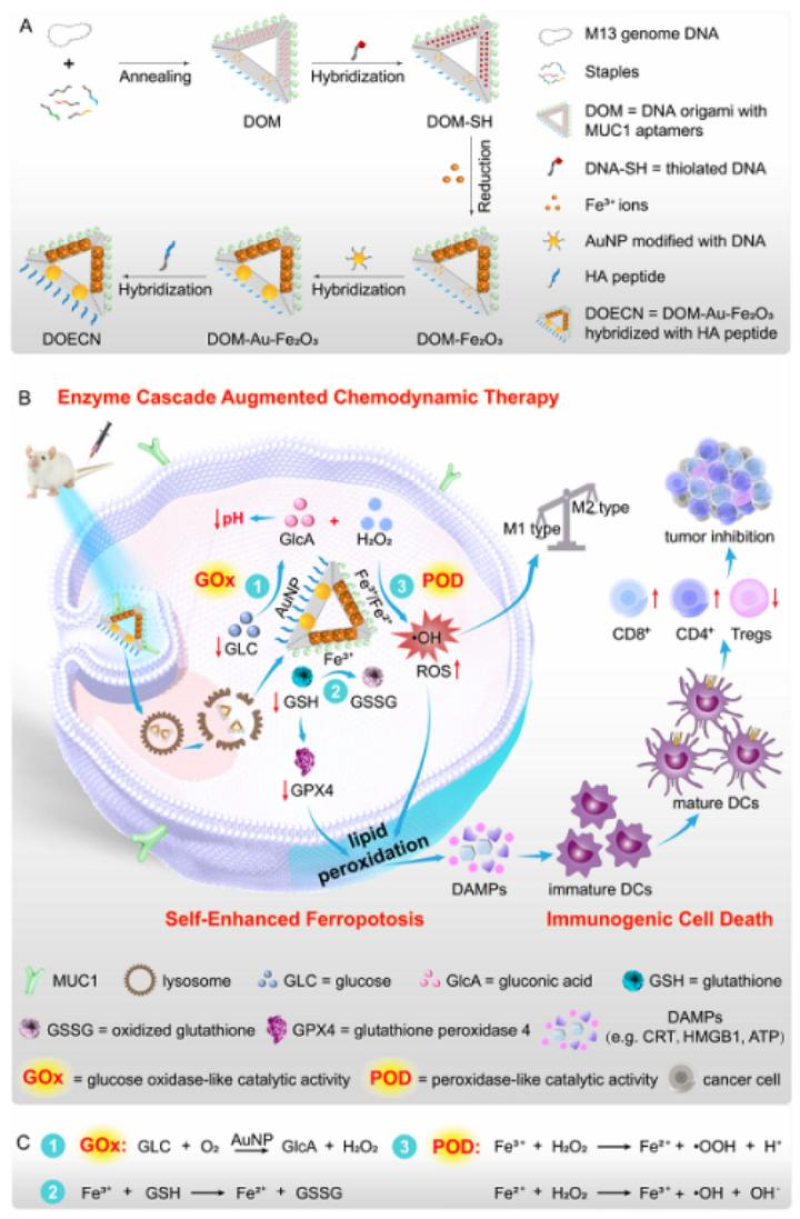
Design and Construction of DNA Origami-Based Enzyme Cascade Nanoreactors
Molecular self-assembled DNA nanostructures, characterized by their precise control, facile modification, and biodegradable nature, are considered potential nanocarriers for targeted drug delivery. In the field of tumor treatment, ROS-based therapies, including chemodynamic therapy, are particularly advantageous for minimally invasive treatment of deep tissue tumors, as they do not rely on oxygen or external energy sources (such as light or ultrasound). However, the efficacy of chemodynamic therapy remains limited.
To tackle these issues, DING Baoquan's team at the National Center for Nanoscience and Technology, Chinese Academy of Sciences, has engineered an enzyme cascade nanoreactor based on DNA origami technology. This innovative nanoreactor enhances the efficiency of chemodynamic therapy and stimulates anti-tumor immunity. By precisely positioning gold nanoparticles with glucose oxidase activity and iron oxide nanoclusters with peroxidase activity on a single DNA origami structure, the nanoreactor optimizes enzyme placement and spacing, thereby boosting catalytic activity and stability.
By promoting hydrogen peroxide generation and glutathione depletion, this design reduces pH levels, which significantly boosts the efficiency of the Fenton reaction. This leads to increased ROS production, amplifying the tumor cell-killing effect. Moreover, the nanoreactor, engineered for targeted delivery, efficiently penetrates cells and induces multiple cell death mechanisms. In murine models, it has demonstrated the capacity to enhance dendritic cell maturation and elicit adaptive immune responses, effectively curbing tumor progression.
The study highlights the feasibility of combining various nanozymes and therapeutic elements with precise integration, paving the way for innovative strategies in tumor therapy.
2. The Innovation丨Decoding the Marine Microbiome at Single-Cell Resolution: Turning Cyclohexane into a Valuable Resource
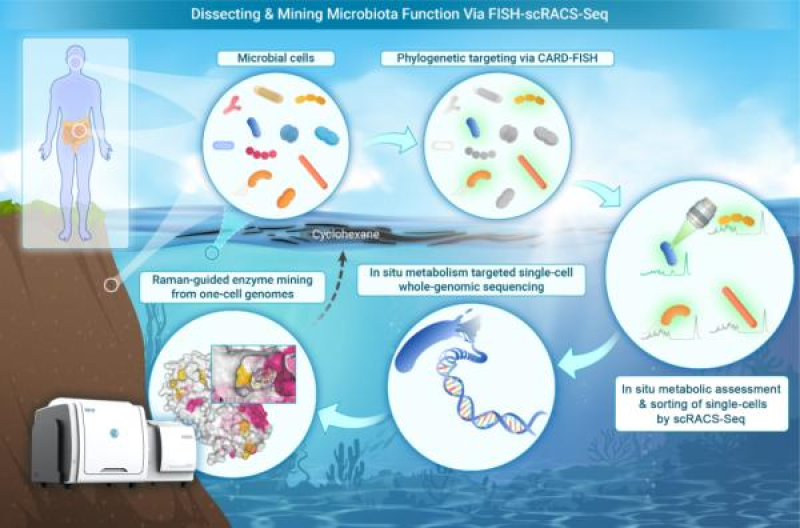
The FISH-scRACS-Seq technology has been employed to dissect and explore the functional potential of microbiomes, providing a comprehensive understanding of microbial activities at the single-cell level.
Recently, a collaborative effort led by the Qingdao Institute of Bioenergy and Bioprocess Technology, Chinese Academy of Sciences, the First Institute of Oceanography, Ministry of Natural Resources, and Shandong University has resulted in the development of a groundbreaking technology called fluorescence in situ hybridization-guided single-cell Raman-activated sorting and sequencing (FISH-scRACS-seq). This innovative approach enables the dual-targeted identification and exploration of functional single cells and their encoded enzyme resources directly from environmental samples, combining species-level and metabolic-level analysis.
The FISH-scRACS-seq (fluorescence in situ hybridization-guided single-cell Raman-activated sorting and sequencing) technology represents a revolutionary approach in microbial ecology and enzyme discovery. By operating at the resolution of a single cell, this technology establishes a comprehensive linkage between five key biological scales: ecological process characteristics, in situ metabolic capacity, whole-genome sequences, metabolic pathways, and enzyme catalytic functions. This multi-scale integration provides unprecedented insights into microbial ecosystems and their functional potential.
Microorganisms and their synthesized enzymes play a vital role in supporting many essential ecological processes in the biosphere. The effective identification and utilization of cells and enzymes with specific in situ metabolic capabilities in the environment are key areas of interest in microbiome research and industry.
The research has introduced the FISH-scRACS-seq technique, employing fluorescence in situ hybridization to pinpoint target microbes and single-cell Raman spectroscopy to assess their metabolic activities, thus enabling dual-targeted "species-metabolism" single-cell isolation and whole-genome sequencing.
Validated in both pure culture mixed systems and intricate soil microbiota, the technology has exhibited high specificity and sensitivity, with genome coverage reaching 99.14%. This advancement has supported the comprehensive discovery of enzyme genes or regulatory components linked to in situ cellular metabolic functions.
Further studies have identified γ-proteobacteria with cyclohexane-degrading capabilities in the Bohai Sea, revealing that Pseudoalteromonas exhibits remarkable efficiency in cyclohexane degradation. This process is facilitated by its unique P450 enzyme system (P450PsFu), which converts toxic cyclohexane into non-toxic cyclohexanol in vitro. Although this enzyme is rare in the global marine microbiome, it is notably prevalent in cold marine environments.
These findings provide valuable insights into cycloalkane degradation mechanisms in low-temperature marine ecosystems and highlight its potential for bioremediation of hydrocarbon contamination. By integrating FISH-scRACS-seq technology with microbiome association analysis, researchers have developed a robust and innovative approach to elucidate the intricate relationships between cellular metabolic functions and enzymatic catalytic activities within ecosystems.
3. The Plant Cell丨The Hidden Link: Temperature, Membrane Fluidity, and PSII Repair
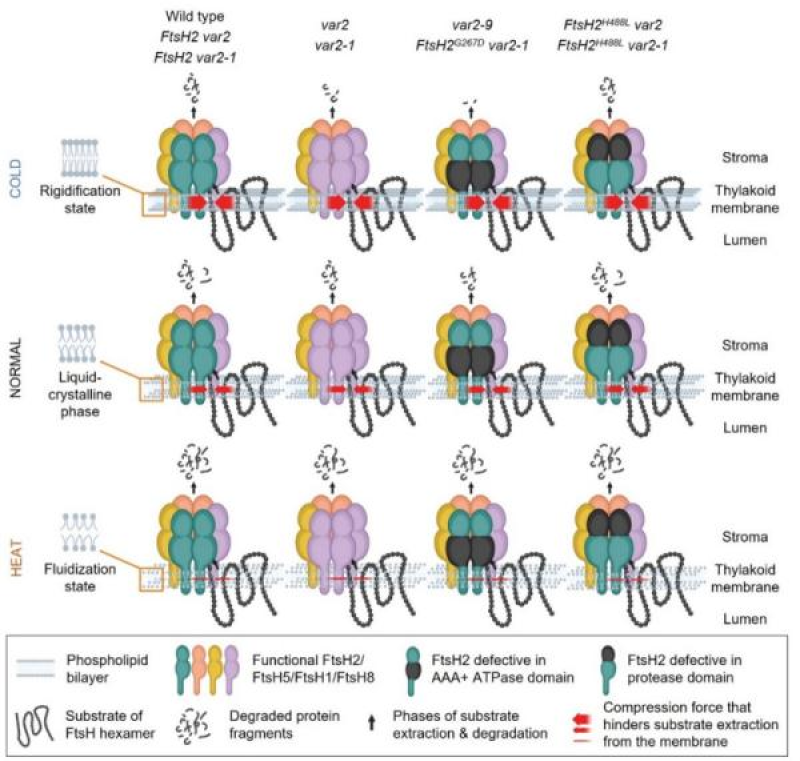
Schematic representation of a working model of the effect of changes in membrane fluidity at varied temperatures on PSII repair in different genotypes
Photosynthesis, a cornerstone of life on Earth, is not without its challenges. During the intricate process of energy conversion, it inadvertently generates detrimental by-products known as reactive oxygen species (ROS). These ROS pose a significant threat to the integrity of the photosynthetic machinery by disrupting the lipid membrane structure and impairing membrane-integrated proteins, particularly the core proteins of photosystem II. Such damage can lead to a decline in photosynthesis efficiency and, consequently, a reduction in plant productivity. Hence, the prompt and efficient repair of photosystem II proteins is essential for preserving the stability and functionality of the photosynthetic system amidst the ever-changing environmental conditions.
Recently, a study led by researcher Chanhong Kim at the CAS Center for Excellence in Molecular Plant Sciences has unveiled a novel mechanism by which temperature changes regulate PSII repair through modulating membrane fluidity. The research has found that mutants lacking the FtsH2 protease exhibit cold sensitivity under low temperatures but remain unaffected by high temperatures. It has revealed that cold stress reduces membrane fluidity, necessitating enhanced substrate extraction by the FtsH2-containing complex rather than its protease activity to maintain PSII function. Conversely, at higher temperatures, increased membrane fluidity allows other FtsH components to sufficiently handle substrate extraction. This study has highlighted the critical role of membrane fluidity in PSII repair under varying temperatures and its thermodynamic characteristics.
This study has deepened our understanding of how temperature stress affects plant biological processes by altering membrane fluidity and has provided new perspectives for exploring chloroplast function and stress adaptation. These findings have been crucial for understanding photosynthetic adaptation and improving crop stress tolerance.
4. Cell Reports丨A Novel Single-Cell Lineage Tracing Technology Unveiled

Schematic representation of the DuTracer design and its application to organoids
A lineage-tracing strategy, DuTracer, has been developed by PENG Guangdun’s team at the Guangzhou Institutes of Biomedicine and Health, Chinese Academy of Sciences. By integrating CRISPR-Cas9 and Cas12a, this breakthrough improves the accuracy and depth of lineage tracing, offering fresh insights into embryonic development, organ regeneration, and disease mechanisms.
In biology, cellular genealogical tracing is akin to constructing a detailed family tree for cells, meticulously tracking their journey from origin to differentiation. Traditional methods, however, are constrained by technological limitations, often capturing only fragmented and incomplete data. Although CRISPR-based gene editing has significantly enhanced resolution, it is not without its flaws. A notable issue is the deletion of large genomic segments between target sites, analogous to losing critical generational details when documenting a family’s history. This limitation underscores the need for more precise and comprehensive tracing technologies.
DuTracer’s breakthrough involves using both Cas9 and Cas12a nucleases while controlling their activation timing to prevent interference from multi-target editing. Experimental results has shown it cuts harmful deletions by over 90% in mouse stem cells and organoids, while capturing deeper cell division levels for more precise mapping of differentiation paths.
5. JACS丨Tiny pores, Giant Impact: The Water-Harvesting Miracle of Novel COFs
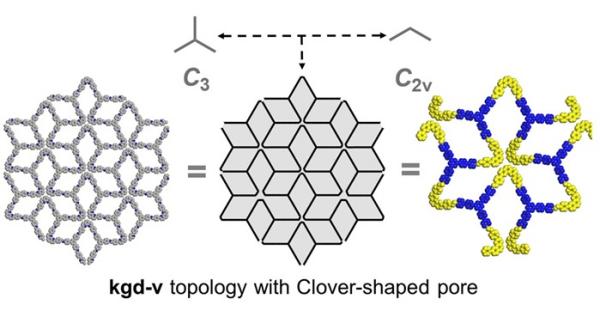
Progress in topological studies of covalent organic frameworks
With water shortages becoming a growing concern, researchers from the National Center for Nanoscience and Technology and the University of Chinese Academy of Sciences have teamed up to create a groundbreaking material for extracting water from the air. The material, made of two types of covalent organic frameworks (clv-COFs) with cloverleaf-like pores and a unique kgd-v structure, is particularly effective at capturing water in low-humidity environments.
Generally, materials with pores smaller than 1.2 nm can efficiently absorb water when humidity is below 70%. In this study, the team designed two new COFs using C2v- and C3-symmetric monomers. These materials not only have the ideal pore sizes but also make the production process simpler. Tests revealed that their pore sizes are 1.0 nm and 1.2 nm, respectively, and both show excellent crystallinity.
Experimental results have revealed that clv-COF-1 is capable of absorbing up to 131 mg of water per gram at 50% humidity, finishing the process in just 100 minutes per cycle. Under real-world conditions (28°C, 45% humidity), it has achieved a daily water collection rate of approximately 1.73 liters per kilogram of material. This underscores its significant potential to address water scarcity challenges.
6. Double Impact: Unlocking the Anti-Cancer Promise of NFN@C Nanocatalyst
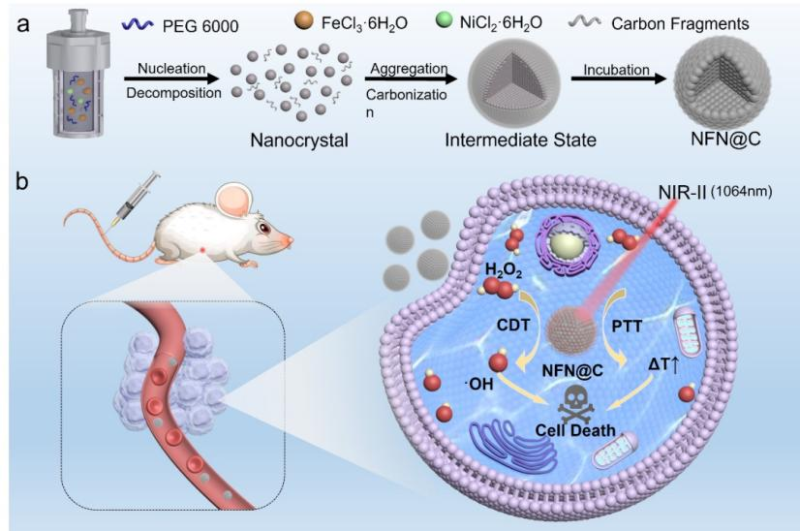
Synthesis of NFN@C catalysts and schematic diagram of tumour catalytic therapy
Recently, researchers at the High Magnetic Field Laboratory of the Hefei Institutes of Physical Science, CAS have developed a novel carbon-coated nickel ferrite nanocatalyst (NFN@C) using electron paramagnetic resonance (EPR) measurement technology based on the Steady High Magnetic Field Experimental Facility. Their findings reveal the potential of NFN@C in anti-tumor therapy.
This study incorporated nickel into the crystal structure of Fe₃O₄ to develop a carbon-coated nickel ferrite nanocatalyst (NFN@C). The addition of nickel optimized the catalyst’s electronic structure, enabling it to more efficiently convert hydrogen peroxide into hydroxyl radicals in the tumor microenvironment, thereby enhancing chemodynamic therapy. Using electron paramagnetic resonance (EPR) technology, the researchers observed an increase in hydroxyl radical signals, confirming that nickel incorporation improved the efficiency of the Fenton reaction. Additionally, NFN@C demonstrated excellent photothermal conversion capabilities under near-infrared light irradiation, achieving a synergistic effect between photothermal therapy and chemodynamic therapy, further boosting its anti-tumor efficacy.
The research team also conducted in - depth theoretical calculations to analyze the influence of nickel doping on the electronic structure of NFN@C. The results show that nickel doping changes the local electron density of the reactive centers in the catalyst, reduces the activation energy of the Fenton reaction, and improves the reaction's selectivity and efficiency. This provides a theoretical basis for optimizing catalyst design and new ideas for optimizing similar nanomaterials in other applications.
Experimental results have shown that NFN@C exhibits excellent anti-tumor efficacy in vitro and superior tumor suppression capabilities in animal studies. When combined with second near-infrared (NIR-II) light irradiation, NFN@C significantly has increased tumor cell mortality, showcasing enhanced therapeutic effects. The optimized design of this nanocatalyst has improved catalytic activity, offering a promising new direction for future cancer treatment.
Columnist: Zang Wei
Translator: Liu Kaiyuan